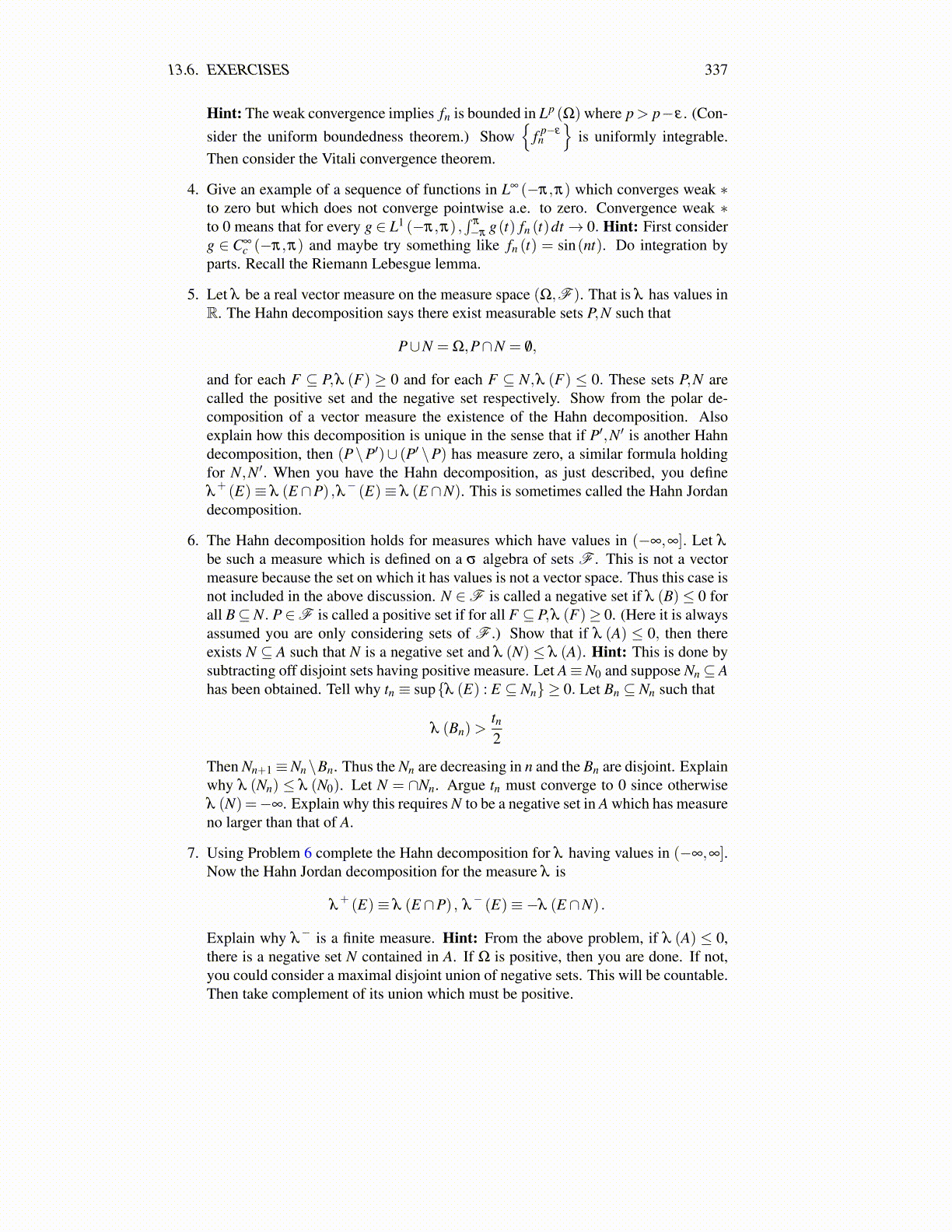
13.6. EXERCISES 337
Hint: The weak convergence implies fn is bounded in Lp (Ω) where p> p−ε . (Con-sider the uniform boundedness theorem.) Show
{f p−εn
}is uniformly integrable.
Then consider the Vitali convergence theorem.
4. Give an example of a sequence of functions in L∞ (−π,π) which converges weak ∗to zero but which does not converge pointwise a.e. to zero. Convergence weak ∗to 0 means that for every g ∈ L1 (−π,π) ,
∫π
−πg(t) fn (t)dt→ 0. Hint: First consider
g ∈ C∞c (−π,π) and maybe try something like fn (t) = sin(nt). Do integration by
parts. Recall the Riemann Lebesgue lemma.
5. Let λ be a real vector measure on the measure space (Ω,F ). That is λ has values inR. The Hahn decomposition says there exist measurable sets P,N such that
P∪N = Ω,P∩N = /0,
and for each F ⊆ P,λ (F) ≥ 0 and for each F ⊆ N,λ (F) ≤ 0. These sets P,N arecalled the positive set and the negative set respectively. Show from the polar de-composition of a vector measure the existence of the Hahn decomposition. Alsoexplain how this decomposition is unique in the sense that if P′,N′ is another Hahndecomposition, then (P\P′)∪ (P′ \P) has measure zero, a similar formula holdingfor N,N′. When you have the Hahn decomposition, as just described, you defineλ+ (E)≡ λ (E ∩P) ,λ− (E)≡ λ (E ∩N). This is sometimes called the Hahn Jordan
decomposition.
6. The Hahn decomposition holds for measures which have values in (−∞,∞]. Let λ
be such a measure which is defined on a σ algebra of sets F . This is not a vectormeasure because the set on which it has values is not a vector space. Thus this case isnot included in the above discussion. N ∈F is called a negative set if λ (B)≤ 0 forall B⊆N. P∈F is called a positive set if for all F ⊆ P,λ (F)≥ 0. (Here it is alwaysassumed you are only considering sets of F .) Show that if λ (A) ≤ 0, then thereexists N ⊆ A such that N is a negative set and λ (N)≤ λ (A). Hint: This is done bysubtracting off disjoint sets having positive measure. Let A≡N0 and suppose Nn ⊆ Ahas been obtained. Tell why tn ≡ sup{λ (E) : E ⊆ Nn} ≥ 0. Let Bn ⊆ Nn such that
λ (Bn)>tn2
Then Nn+1≡Nn\Bn. Thus the Nn are decreasing in n and the Bn are disjoint. Explainwhy λ (Nn) ≤ λ (N0). Let N = ∩Nn. Argue tn must converge to 0 since otherwiseλ (N) =−∞. Explain why this requires N to be a negative set in A which has measureno larger than that of A.
7. Using Problem 6 complete the Hahn decomposition for λ having values in (−∞,∞].Now the Hahn Jordan decomposition for the measure λ is
λ+ (E)≡ λ (E ∩P) , λ
− (E)≡−λ (E ∩N) .
Explain why λ− is a finite measure. Hint: From the above problem, if λ (A) ≤ 0,
there is a negative set N contained in A. If Ω is positive, then you are done. If not,you could consider a maximal disjoint union of negative sets. This will be countable.Then take complement of its union which must be positive.